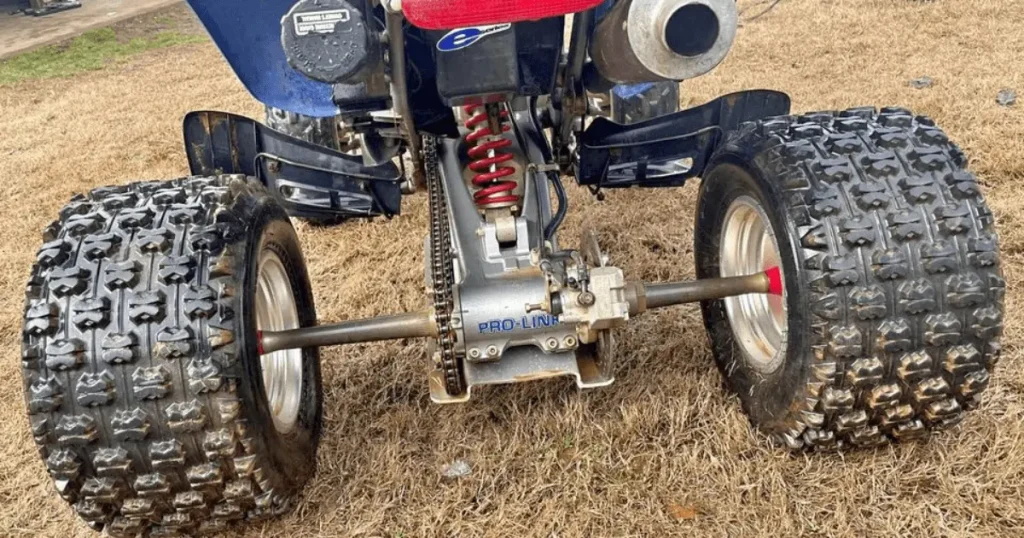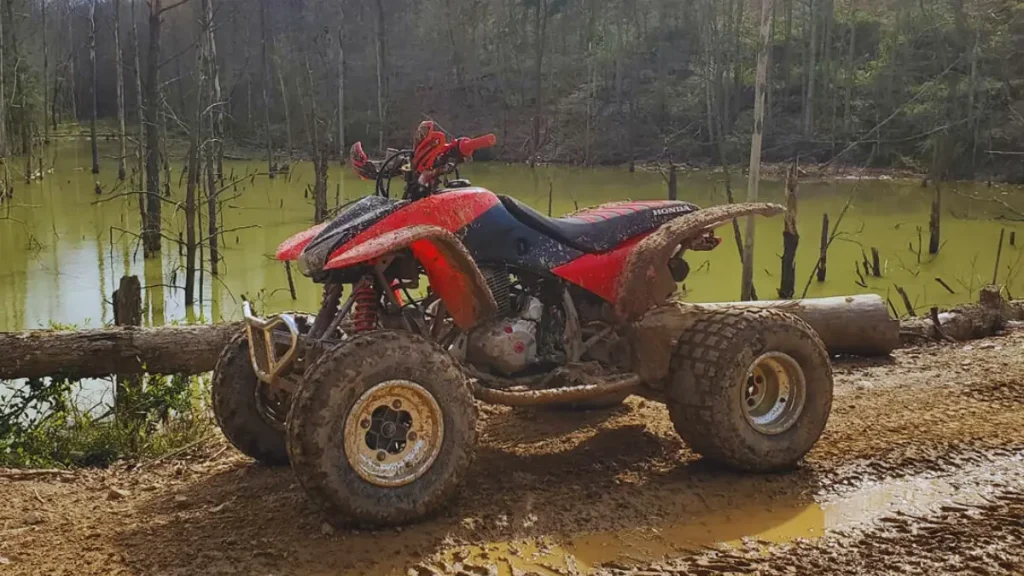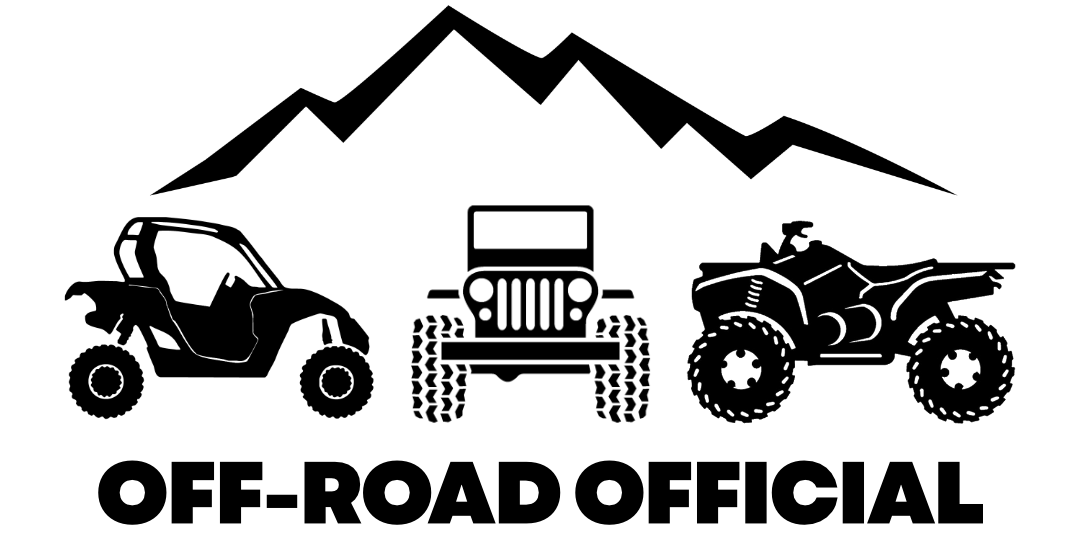If you’re considering purchasing a Honda 400EX, you’ve come to the right place.
Spoiler Alert for what’s ahead: the 400EX not only makes for one of the best used ATV models you can buy, but also might just be the best trail riding option ever produced.
We’ll tell you why in this guide, while also detailing the following:
- Brief History & Overview of the Honda 400EX
- Build Quality & Performance
- Top Speed
- Why Its Handling Makes It The Trail & Wheelie King
- How Much Value 400EX Models Hold Today
- What Owners Love
- What Owners Don’t Love
- How They Compare With Honda 300EX, Raptor 350 & Banshee 350
About The Honda 400EX
The Honda 400EX boasts sporty body styling, a four-stroke 397-cc engine with an output of around 28 horsepower, aggressive all terrain tires, and a suspension system that offers a smooth ride in most any terrain.
Known for its excellent handling, many riders consider this model one of the best trail riding ATVs ever made.

The Honda 400EX burst onto the scene in 1998, at a time when the sport ATV market was just beginning to rebound from the guidelines set forth by the Consent Decrees of 1988 that seemed to cripple the industry for almost ten years.
Announcing its arrival in style with a win at the ‘98 Baja 1000, the 400EX would go on to see an impressive ten-year production run through 2008.
It is credited with helping revive the sport ATV industry as one of the first four-stroke quads, paving the way for the Honda 450R and the many more modern sport models that came along after it.
Build Quality & Performance
Engine
The 400EX is powered by a four-stroke, air-cooled 397 cc engine with a power output of around 28 HP.
A 38 mm Keihin carburetor feeds the air-fuel mixture into the radial four-valve combustion chamber.
The engine provides plenty of low-end torque to motor riders around wooded areas, trails, or deserts.
Though the horsepower and speed at high RPMs leaves something to be desired, this quad will not disappoint on the trail.
And similar to that of the Honda 300EX, this engine is as bulletproof as they come.
This bodes well for long-term owners and owners of used models alike, as ensuring regular oil changes and resetting the valve clearances every so often should make up the majority of the mechanical work needed to keep these engines running for a long time.
| Engine Type | Four-Stroke SOHC, gas |
| Cylinder Arrangement | Single Cylinder, Forward Inclined |
| Displacement | 397 cc |
| Horsepower | 28 HP |
| Bore x Stroke Ratio | 74 x 66 mm |
| Compression Ratio | 9.1:1 |
| Carburetion System | Carburetor, Keihin 38 mm piston-valve w/ accelerator pump |
| Engine Cooling | Air-Cooled |
| Fuel Capacity | 2.64 Gallons |
| Starter Type | Electric |
| Ignition System | CDI with electronic advance |
| Battery | 12V 8Ah |
| Spark Plug | DPR8Z (NGK)X24GPR-U (DENSO) |
Drivetrain
The 400EX is chain-driven, with only two-wheel drive.
The chain links a five-speed transmission to the axle and provides power to the rear wheels.
Models manufactured before 2005 do not have a Reverse setting, with that changing in the 2005+ models.
Honda’s chain adjuster regulates the chain drive, eliminating the need for alignments and making it easy for owners to make quick adjustments.
This design helps to eliminate premature chain and sprocket wear due to improper alignment.
| Drive System | Chain Drive, O-Ring |
| Transmission Type | Manual |
| Gears | Pre-2005 Models – 5-Speed2005+ Models – 5-Speed w/ Reverse |
| Gear Shift Pattern | Pre-2005 Models – 1 – N – 2 – 3 – 4 – 5 2005+ Models – R/1- N – 2 – 3 – 4 – 5 |
Tires & Brakes
The 400EX is outfitted with 22-inch Ohtsu stock tires in the front and 20-inch Ohtsu stock tires in the rear.
These radial tires provide plenty of grip with their knobby design, but a number of owners have upgraded to Maxxis Razr tires or ITP Holeshot XC/XCT tires of the same 22” and 20” sizes and seen better results.
The dual single-piston hydraulic brakes in front provide remarkable stopping power while the single-piston hydraulic disc in the rear provides balance when stopping.
This braking system provides remarkable stopping power in all terrains, even in wet conditions.
| Front Tires | 22 x 7-10 |
| Rear Tires | 20 x 10-9 |
| Recommended Tire Pressure | Front – 4.0 psiRear – 4.0 psi |
| Wheels | Aluminum |
| Front Brake Type | Dual Hydraulic Disc |
| Rear Brake Type | Hydraulic Disc |
Suspension

With a double wishbone suspension in front and a Pro-Link swing arm suspension in back, riders will find traversing most terrains at any speed incredibly smooth.
The Showa shocks do an awesome job of soaking up bumps, and they are all preload adjustable to enable increasing the standard ground clearance of 4.3 inches when desired.
The suspension system offers 8.2 inches of front travel and 9.1 inches of rear travel, and it makes for smooth landings when jumping.
| Front Suspension | Independent Double-A Wishbone w/ Preload Adjustable Dual Showa Shocks |
| Rear Suspension | Pro-Link Swing Arm w/ Preload Adjustable Single Showa Shock |
| Wheelbase | 48.4 inches |
| Ground Clearance | 4.3 inches |
| Turning Radius | 10.5 feet |
Dimensions
The 400EX features a compact build, making it nimble and highly capable of snaking through tight trails at a brisk pace.
And at a dry weight of 375 lbs this model is easy to steer and turn, feeling extremely light when handling it.
| Length | 72.2 inches |
| Width | 45.3 inches |
| Height | 43.7 inches |
| Seat Height | 31.9 inches |
| Dry Weight | 375 lbs. |
Honda 400EX Top Speed
The Honda 400EX top speed is between 65 and 68 mph in a fully stock machine.
However, plenty of owners have made modifications to their ATV in order to increase the top speed to 75+ mph and keep up with the Yamaha Raptor 700’s and Polaris Scrambler XP 1000’s of the ATV world.
Others find that their quad will not quite reach these top speeds, likely due to the amount of wear on the engine.
You’ll find some ways to increase the top speed of the Honda 400EX at the end of this guide.
How The 400EX Handles – The Trail & Wheelie King
It’s hard to find an ATV that handles better than the Honda 400EX, especially when it comes to riding tight trails.
It has good low end acceleration, the throttle response is excellent, and the manual clutch is easy to use.
While being geared low is a big advantage on the trails, it does limit the top speed.
But for those who mostly trail ride and rarely get above third gear, you’d never know it.

In fact, the 400EX performs about as well as any sport model out there while in the first three gears.
Consistent stability at any speed or when cornering is also a plus. And it has excellent balance when riding wheelies, which are easy to come by with this machine when desired.
Giving it some gas after a slight pull on the handlebars will lift the front end and help riders over obstacles or puddles on the trail.
Like the Honda 300EX, this model also suffers from some twitchiness in the handlebars if hitting a bump or hole with only one tire when the rider is not braced for it with a firm grip.
Additionally, it may run into trouble riding in soft, steep terrain like sand dunes.
Models And Changes
The Honda 400EX saw plenty of models produced from 1998 to 2008.
While early models remained unchanged for the most part, the 2005 model kicked off the first round of changes in the form of new bodywork, upgrades to the suspension, and the addition of a Reverse gear.
Going out with a bang for its final year of production, the 2008 model got one last touch-up in the form of more modern bodywork and plastics.
Honda 400EX Value
How much is a Honda 400EX worth?
Using data from NadaGuides, the table below will show the initial list price for new models and the current average retail price for used models by year.
| Year, Make & Model | List Price | Average Retail Price |
| 1999 Honda 400EX | $5,499 | $1,265 |
| 2000 Honda 400EX | $5,699 | $1,425 |
| 2001 Honda 400EX | $5,699 | $1,615 |
| 2002 Honda 400EX | $5,699 | $1,815 |
| 2003 Honda 400EX | $5,699 | $2,035 |
| 2004 Honda 400EX | $5,699 | $2,165 |
| 2005 Honda 400EX | $5,799 | $2,295 |
| 2006 Honda 400EX | $5,899 | $2,430 |
| 2007 Honda 400EX | $5,999 | $2,595 |
| 2008 Honda 400EX | $5,999 | $2,785 |
Even all these years later, the Honda 400EX is well respected and popular among the off-roading community.
As such, these models tend to hold their value well. Most used models listed on sites like ATV Trader and Facebook Marketplace are listed for between $2,000 and $4,000 depending on the year and condition.
And the good news for owners considering a used 400EX is they’re not often used for racing and they tend not to break. They’re also one of the cheaper ATVs to rebuild or restore, with plenty of aftermarket parts still available.
What Owners Love About The 400EX
- The engine is as close as can be to bulletproof with very few mechanical flaws.
- Reverse setting in 2005+ models a big help for trail riding or if stuck.
- Compact enough to fit in the back of a pickup truck.
- Excellent handling makes it a top choice for trail riding.
- Great balance when doing wheelies.
- Lives up to the mantra that “Hondas don’t break”.
- Many aftermarket parts still available for cheap.
What Owners Don’t Love About The 400EX
- The wiring harness behind the headlights in early models is prone to wearing out and causing shorts..
- The factory front shocks are the weak link in an otherwise solid suspension system. Recommend an upgrade to 450r shocks for best performance.
- The rear grab bar is part of the subframe so if it breaks there’s no replacing it. Many owners attach a modified grab bar to it to try and prevent this from happening.
- A ticking sound can sometimes be heard when riding, usually signaling the valves need to be adjusted and/or the timing chain may need to be replaced.
- While this model is great for jumping, the swing-arms are prone to cracking if landing on hard surfaces.
- Power and speed are not that impressive on flat surfaces.
Comparable ATVs
A few of the quads that compare the closest to both the features and performance of the Honda 400EX are the Yamaha Banshee 350, Yamaha Raptor 350, and Honda 300EX. Below is a side-by-side comparison of the key features.
Honda 400 EX vs Yamaha Banshee 350
| Features | Yamaha Banshee 350 | Honda 400EX |
| Engine Displacement | 347 cc | 397 cc |
| Stock Horsepower | 34 hp | 28 hp |
| Top Speed | 75 mph | 68 mph |
| Ground Clearance | 5.3 inches | 4.3 inches |
| Dimensions in Inches (L x W x H) | 75 x 41 x 42 | 72 x 45 x 44 |
Honda 400 EX vs Yamaha Raptor 350
| Features | Yamaha Raptor 350 | Honda 400EX |
| Engine Displacement | 349 cc | 397 cc |
| Stock Horsepower | 22 hp | 28 hp |
| Top Speed | 63 mph | 68 mph |
| Ground Clearance | 4.5 inches | 4.3 inches |
| Dimensions in Inches (L x W x H) | 70 x 43 x 42 | 72 x 45 x 44 |
Honda 400 EX vs Honda 300EX
| Features | Honda 300EX | Honda 400EX |
| Engine Displacement | 282 cc | 397 cc |
| Stock Horsepower | 21 hp | 28 hp |
| Top Speed | 58 mph | 68 mph |
| Ground Clearance | 4.9 inches | 4.3 inches |
| Dimensions in Inches (L x W x H) | 68 x 43 x 42 | 72 x 45 x 44 |
Increasing the Honda 400EX Top Speed
If you want to increase the top speed of the Honda 400EX to 75+ mph, the following mods will help you get there.
Upgrade the Air Intake System
The intake system consists of the air filter and airbox. This system permits clean air to flow into the engine and determines how much fuel is fed to the engine, which both affect the amount of power and speed produced.
By upgrading this system, more clean airflow will reach the engine so that the machine performs better. The more air in and out, the more power and speed the engine will generate.
An upgrade to a K&N filter or a Uni filter are recommended, but there are a number of aftermarket kits available to choose from specific to the Honda 400EX.
Upgrade The Exhaust System
In order to provide a more efficient escape for this added airflow once used up, owners should upgrade the exhaust system as well.
An upgraded exhaust system will add more horsepower and torque to your ATV and help increase the speed.
Both HMF Racing and Sparks Racing make highly recommended upgraded exhaust systems for the 400EX.
Re-jetting the Carburetor
Since upgrading the intake and exhaust increases the airflow, you need to increase the fuel flow as well to keep the air to fuel ratio correct. You can increase the fuel flow by re-jetting the carburetor.
There are three different jets that will need an update – the pilot jet, the needle jet, and the main jet.
The pilot jet and the main jet will need to be replaced with bigger jets, while the needle jet simply needs a turning adjustment.
The stock jets in the 400EX are a #38 pilot jet and a #148 main jet.
It is recommended that owners upgrade to a #42 pilot jet and a #165 or #170 main jet for the best performance if making mods to the 400EX.
Additionally, it is recommended to adjust the needle jet between a half turn and a full turn.
There are a number of different aftermarket jet kits available for the Honda 400EX, but simply purchasing the replacement jets on their own will save you some coin.
Tires, Fuel, and Spark Plug
Replacing the stock front Ohtsu 22-inch tires and rear Ohtsu 20-inch tires with slightly larger-diameter tires may help you reach a faster top speed, as will ensuring the tires are all fully inflated to their recommended PSI.
Running a high octane fuel in your quad is another way to increase speed.
Using 91 or 93 octane gas will result in higher engine performance and speed in this model.
Ensuring the spark plug is not fouled will also have a positive effect, as a faulty spark plug may not ignite fuel in the engine at a proper rate, resulting in a lower speed.
It is recommended to install an iridium spark plug for top performance.
Final Word
The Honda 400ex was a game changer when it burst onto the sport ATV scene. It possessed some of the best trail performance ever seen in a quad at the time.
Couple this performance with the durability to withstand plenty of rough riding and the dependability you’d expect from a Honda, and it’s easy to understand why this model remains one of the more popular trail quads still today.
For those who may want a used sport ATV that can match just about any other on the trail and has plenty of life left in it, the Honda 400ex is very much worth consideration.


